Читать книгу The Movement for Reproductive Justice - Patricia Zavella - Страница 22
Conclusion
ОглавлениеReproductive justice advocates critique deficit thinking that blames subjects for their experiences of marginalization in relation to health, and they take a strengths-based approach. The reproductive justice organizations discussed here—Black Women for Wellness, California Latinas for Reproductive Justice, Forward Together, the National Latina Institute for Reproductive Health, SisterSong Women of Color Reproductive Justice Collective, Strong Families Network, Strong Families New Mexico, the Afiya Center, Western States Center, and Young Women United—and other reproductive justice organizations also engage in activist research. However, they also push our understanding of what activist research means. Their research enables them to better understand the nuances of women’s experiences and to tailor interventions that garner trust and civic engagement with the aim of addressing structural inequalities and blaming discourses. These organizations use unexpected findings from their research and construct key frames—such as “soy poderosa,” “somos chingonas,” “strong families,” “young parents,” and “Black mamas matter”—that then inform their policy strategies.
By using the overall framing of human rights with intersectionality, reproductive justice organizations recognize both the diversity within communities of color and the historically specific struggles faced by particular social groups. They expect a standard of human dignity informed by human rights in which health care and the discourse about the struggles of women of color are culturally sensitive. Moreover, they offer a range of theories—concepts, metaphors, stories, models, and accounts—offering interpretive frames for making sense of evidence that is often ignored by political pundits, the public, and academic researchers. And they draw on the cultural practices in communities of color that allow for emotional expression. In this case, theory constructed by practitioners, designed, according to Faye Harrison, to “save our own lives,” offers an innovative, multifaceted approach to framing.115
Further, the reproductive justice social movement illuminates its fluid engagement with multiple powerful forces. It illustrates the sociologist Marc Steinberg’s point that “by artfully transforming the meaning of the discourses used to dominate them, challengers both provide their claims with credibility and cast doubt on the often assumed truths power holders voice through these words.”116 The artfulness of reproductive justice framing is particularly evident when representing the diversity of families in the United States. The intertextuality of discursive strategies is also striking: organizations use the slogans, images, research findings, and framing of sister reproductive justice campaigns and acknowledge one another’s contributions. Reproductive justice advocates emphasize the diverse subjectivities, identities, emotions, and lived resiliency of women of color. More importantly, by recruiting women to engage in the internal work of contesting how they are represented by the dominant society, reproductive justice organizations work with women to find their “own place in this work” and begin the process of empowerment. By nurturing strengths-based approaches, reproductive justice activists contend that anyone can identify with powerful women.
